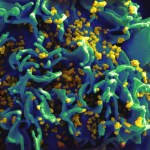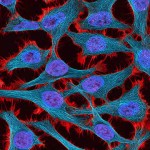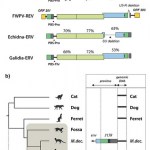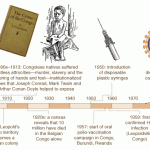hiv
Image by Keith Weller, USDA via Wikimedia Commons
Researchers at the International AIDS Vaccine Initiative at Scripps Research Institute have discovered that cows can produce antibodies that effectively neutralize HIV. Thus far, developing an effective vaccine for HIV has been hampered by the ability of the virus to mutate. Some people who have been infected with the virus for a period of years develop antibodies that are able to attack parts of the virus that do not mutate. Cows exposed to HIV, on the other hand, begin developing these antibodies within weeks of…
A few of the recent pieces I recommend reading:
Sarah Kliff & Ezra Klein at Vox: The Lessons of Obamacare
Chris Ladd in Forbes: Unspeakable Realities Block Universal Health Coverage in the US
Donelle Eller in the Des Moines Register: Iowa pollution enforcement could lose big under Trump EPA cuts, critics warn
Teddy Wilson at Rewire: Texas Legislators "Ignore" Spiking Black Maternal Mortality Rates
Linda-Gail Bekker & Anthony S. Fauci at STAT: Women are Leading the Way in HIV Research
And because the House Republicans' healthcare bill is so consequential for public health and there's…
On Aetiology, Tara C. Smith explores the story of Gaetan Dugas, a man who was long blamed for precipitating the AIDS epidemic in the United States. The vilification of Dugas had nothing to do with science; instead he was dubbed "patient zero" in a misinterpretation of his study moniker "patient O" (for Outside). Dugas' portrayal in the media turned him into a modern Typhoid Mary, but he was not an originator of the U.S. epidemic, as a 2007 molecular analysis proved and a new paper in Nature confirms. Smith writes "This is the real scandal and lingering tragedy of Dugas. His story was used to…
The news over the past 24 hours has exclaimed over and over:
HIV's Patient Zero Exonerated
How scientists proved the wrong man was blamed for bringing HIV to the U.S.
Researchers Clear "Patient Zero" from AIDS Origin Story
H.I.V. Arrived in the U.S. Long Before ‘Patient Zero’
Gaetan Dugas: "patient zero" not source of HIV/AIDS outbreak, study confirms
HIV's supposed "Patient Zero" in the U.S., Gaetan Dugas, is off the hook! He wasn't responsible for our outbreak!
This is presented as new information.
Gaetan Dugas, from Wikipedia.
It is not, and I think by focusing on the "exoneration" of…
For public health workers, it’s no surprise that social, economic and political conditions shape the distribution and burden of disease. They’ve always known that it takes much more than medicine to keep people healthy. Still, when public health scientist Kristina Talbert-Slagle decided to study the impact of social and public health spending on HIV/AIDS, she wasn’t sure what she’d uncover.
“We thought that maybe there would be a connection, but we didn’t really know what to expect,” said Talbert-Slagle, a senior scientific officer at the Yale Global Health Leadership Institute and a lecturer…
For the first time since 2006, cases of chlamydia, gonorrhea and syphilis are on the rise, according to new data from the Centers for Disease Control and Prevention. The agency reports that while the sexually transmitted diseases continue to impact young people and women most severely, the recent increases were driven by rising disease rates among men.
Released just today as part of CDC’s Sexually Transmitted Disease Surveillance 2014 report, the data finds that chlamydia cases are up 2.8 percent since 2013; primary and secondary syphilis (the most infectious stages of the disease) are up 15.…
Long-term readers of the blog know of my interest in HIV denialism, especially as it is maintained and spread via the Internet. In my online travels, I recently met John Strangis via this blog post. John has an interesting story to tell regarding his experiences with HIV denialism and subsequently, his turn to patient and science activism. Many thanks to John for sharing it here.
John with his wife and son.
TS: Can you tell the readers a bit about yourself?
JS: My name is John Strangis. I was born in the United States from Italian parents but lived for fifteen…
On ERV, Abbie Smith provides an update on a pioneering treatment for hemophilia that uses viruses to insert missing genes in a patient's DNA. Hemophilia results from from the mutation or deletion of a gene that makes a blood clotting agent called Factor IX; without it, hemophiliacs are at risk for uncontrolled bleeding. While Factor IX can be delivered pharmaceutically, utilizing viruses to modify patients' DNA yields long-term improvements in natural Factor IX production. Abbie writes, "the amount of therapeutic Factor IX these patients needed (on average) dropped from 2613 IU/kg to 206. The…
Stanford medical student Nathan Lo reportedly caused a stir at the Conference on Retroviruses and Opportunistic Infections (CROI) last week when he presented a new finding: After analyzing surveys completed by 800,000 people in 22 sub-Saharan African countries, Lo and his colleagues found "no evidence to suggest that PEPFAR funding of abstinence and faithfulness programs results in reduced high-risk sexual behavior."
Using data from the US-funded Demographic and Health Survey, the Stanford researchers analyzed responses to questions about the number of sexual partners, age of first sexual…
Image of llama from www.healthline.com
Research has suggested that llamas may pack a powerful punch against HIV. This is because they not only have conventional heavy and light chain antibodies like those found in humans, they also have heavy chain-only antibodies as shown below.
Depiction of conventional antibody with heavy and light chains (left) and the heavy chain only antibody found in llamas (right). Figure from www.abcore-inc.com
These so-called "llama antibodies" are smaller than the conventional antibodies found in humans. This helps the antibodies bind more effectively to…
New research from the Weizmann Institute of Science reveals that "cells in our brain form little hexagonal grids that keep us oriented, map-like, in our surroundings." Weizmann's resident blogger describes this finding as "a pyrotechnic flash of insight that changes how we understand the brain to work." Game developers delight; this discovery shows "that you can really apply mathematical models to understand how our mammalian brains get their bearings." It may also have immediate implications for understanding human brain disorders such as vertigo. Meanwhile, on ERV, Abbie Smith explores a…
On Pharyngula, PZ Myers criticizes the stubborn obfuscations of Michael Behe, who refuses to yield his illogical calculations. Behe says (rightly) that a certain mutation necessary for drug resistance in the malaria parasite has about a 1 in 1020 chance of occurring. But the mutation is also detected in 96% of malaria patients who respond well to the drug; it proliferated widely because, by itself, it had no impact on the parasite's fitness. The parasite needed another mutation, occurring at a later date, to develop resistance to the drug. Behe rests his case for divine intervention on the…
Every so often there's an article that starts making the rounds on social media, in particular Facebook and Twitter, that cries out for a treatment by yours truly. Actually, there are more such articles that are constantly circulating on social media that I could work full time blogging and still not cover them all. So I'm stuck picking and choosing ones that either (1) particularly pique my interest; (2) irritate me enough to goad me into action; or (3) reach a level of ubiquity that I can no longer ignore them. I don't think this one's hit #3 yet, but it certainly scores on #1 and #2.…
In a phenomenon known as Peto's paradox, large mammals do not develop cancer more often than small mammals, despite having more cells that could go haywire. On Life Lines, Dr. Dolittle writes "Some researchers suggested that perhaps smaller animals developed more oxidative stress as a result of having higher metabolisms. Others proposed that perhaps larger animals have more genes that suppress tumors." But a new hypothesis argues that large mammals have evolved to minimize the activity of ERVs, which are ancient viral elements integrated into our DNA. Active ERVs can cause cancer and possibly…
Jim Moore and I were both students in the PhD Program in Anthropology at Harvard a few years ago. He graduated about the time I entered the program. To give a rough historical touchstone, I remember the day he needed to get his thesis off to the Registrar, and there was a delay because it was taking longer than expected to deburst the pages fresh out of the printer. Anyway, Jim is Professor of Anthropology at UC San Diego, and has done a great deal of work with Old World Primates, the evolution of social systems, and related topics. A while back Jim wrote an important piece for American…
Does anyone remember the H1N1 influenza pandemic? As hard as it is to believe, that was five years ago. One thing I remember about the whole thing is just how crazy both the antivaccine movement and conspiracy theorists (but I repeat myself) went over the public health campaigns to vaccinate people against H1N1. It was truly an eye-opener, surpassing even what I expected based on my then five year experience dealing with such cranks. Besides the usual antivaccine paranoia that demonized the vaccine as, alternately, ineffective, full of “toxins,” a mass depopulation plot, and many other…
Everything old is new again. For years on this blog, I wrote about HIV denial and the few fringe scientists and journalists who espoused it. I attracted a host of trolls, some of whom repeatedly attacked my credibility, my appearance, even showed up at my academic office. One of the most prolific of these was Henry Bauer, who posts long-debunked ideas on HIV/AIDS (and the Loch Ness Monster to boot).
That was, oh, 2007-ish and prior. In that same year Steven Novella and I co-authored an article on HIV denial for PLoS Medicine. In 2008, a leader of the denial movement, Christine…
Gregg Mitman's article in the September 17th New England Journal of Medicine, "Ebola in a Stew of Fear," is unfortunately all too prescient. Dr. Mitman highlighted "the ecology of fear" in Western Africa. Fear is present on both the part of Westerners (scared of Africa's yellow fever, malaria, Ebola, its mere "different-ness"), and by native Africans (of whites' history of colonization and slavery, of medical exploitation dating back well over a century). Fear of each other.
This history of fear, the cultural legacy of decades of mistrust of both Western people and their medical…
Scientists use a 'gene gun' to insert a gene from a flowering plant called rockcress into the cells of wheat seeds. The genetically modified wheat became more resistant to a fungus called take-all, which in real life can cause "a 40-60% reduction in wheat yields."
T-cells from six HIV+ patients were removed from their bodies, treated with a zinc-finger nuclease designed to snip a gene out of the cell's DNA, and put back in the patients. Removal of the gene mimics a naturally occurring mutation which confers resistance to the HIV virus. But only 25% of the treated cells showed…
Dr. Janet Yamamoto from the University of Florida College of Veterinary Medicine was quoted in a press release this week saying, “One major reason why there has been no successful HIV vaccine to date is that we do not know which parts of HIV to combine to produce the most effective vaccine." Her research team is trying to develop a vaccine that stimulates T cells from people infected with HIV to respond to the feline (FIV) form of the virus. They are working toward that goal by searching for sections of the FIV virus that can activate T cells to attack HIV without mutating.
Dr…











